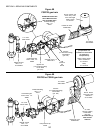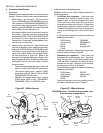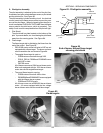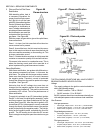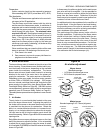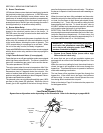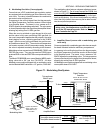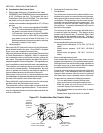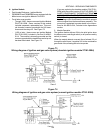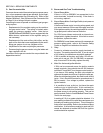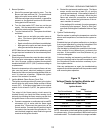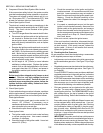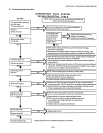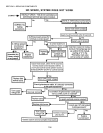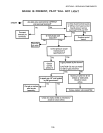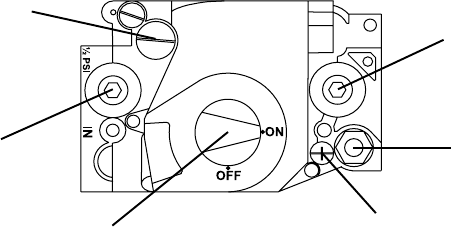
98
M. Combination Gas Control Valve
1. Part Number Reference - Combination Gas Valve
PS360WB70 and PS360EWB ovens are equipped with
a 3/4 (19.05mm) gas line. This requires the use of
Combination Gas Valve P/N 32569. The valve has a
tan plastic cover with a blue On/Off knob.
All other oven models are equipped with a 1/2 (12.7mm)
gas line.
- Through 10/01 - these ovens used Valve P/N 28092-
0017. The valve operated on a 60 Hz supply, had a
tan plastic cover and a blue On/Off knob.
- 11/01 and later - these ovens use Valve P/N 45688.
The valve operates on a 50 or 60 Hz supply, has a
grey plastic cover and a black On/Off knob. It is
otherwise identical to the previous version, and may
be used to replace it in all cases.
2. Valve Operation
When the ON-OFF knob on the valve is in the ON position,
gas is allowed to enter the valve. Once 24VAC is supplied
to the valve, gas is supplied to the pilot line.
When the pilot flame has been proved (see Pilot and Proof
of Flame Rectification on Page 94), 24VAC is supplied to
the combination valve by the ignition module, opening the
main valve. Gas pressure from the inlet side of the valve is
passed through the Pressure Regulator. The regulated pres-
sure is supplied to a cavity below the main valve diaphragm.
This pressure overcomes the spring force and moves the
main valve to its open position. During operation, the main
valve is opened and closed by the pressure regulator to
keep a constant pressure at the outlet of the valve.
When power to the valve is cut, the cavity below the main
valve diaphragm is depressurized and the valve spring closes
the main valve rapidly to shut off the main burner.
When the 24VAC supply to the valve is cut, the valve stops
gas flow to both the pilot and the main burner.
The combination valve includes taps to measure both the
inlet pressure and the regulated pressure. To ensure accu-
racy, the regulated pressure should be measured when the
oven is on low flame.
SECTION 3 - SERVICING COMPONENTS
Figure 72 - Combination Gas Control Valve
On/Off knob (should
remain in ON position)
Inlet
pressure
tap
Regulated
pressure
tap
Pilot pressure
adjustment (under
cap screw)
Pressure
regulator
adjustment
(under cap
screw)
3. Servicing the Combination Valve
Pilot pressure
One of the more common service issues with the com-
bination valve occurs on ovens with the on/off gas regu-
lating system (with a solenoid valve), when the oven is
on low flame. During low flame, the servo can bounce
inside the valve as it searches for the proper level. The
bouncing line pressure can also cause surges in the
pilot pressure. A properly adjusted pilot will tend to
smooth out the surges.
The best way to check for a properly adjusted pilot is
to check the pilot line pressure. This requires a pilot
pressure tap in the pilot line. Ovens built 3/94 or later
should have the tap installed in the line. The tap is
also available as Service Kit P/N 30185 which includes
installation instructions.
Recommended pilot gas pressures are:
- Wayne burner, natural gas - 3½-4 W.C. (8.71-9.95
mbar)
- Wayne burner, propane - 8-10 W.C. (19.9-24.9
mbar)
- Midco burner (all gases) - 5-6 W.C. (12.5-14.9
mbar)
Burrs in pilot adjustment portal
Some combination valves have been shown to have
shipped with small burrs in the pilot adjustment portal.
Although this will not interfere with proper operation of
the valve in any way, it does make it difficult to adjust
the pilot pressure until the burr is removed.
Check for a burr by attaching a manometer to the pilot
pressure tap. If the manometer does not detect any
change in pilot pressure when the screw is tightened
all the way down, there is probably a burr in the portal.
To remove a burr, perform the following procedure:
- Turn the adjustment screw all the way down.
- Apply more pressure to break through the burr.
- Back the screw out until the top of the screw is
level with the top of the access hole.
- Turn the adjustment screw back down to adjust
the pressure.
- Repeat these steps until the burr is cleared.
Pilot line
connection



